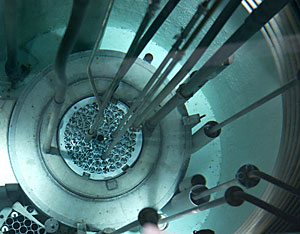 |
|
CHRIS CODUTO/Arizona Daily Wildcat
|
Shown here is the inside of UA's nuclear reactor vessel in the engineering building. The reactor will be decommissioned in the year 2010.
|
|
|
By J. Ferguson
Arizona Daily Wildcat
Thursday, January 27, 2005
Print this
The last remnants of the nuclear engineering program died Monday, when the UA Faculty Senate voted to end the graduate program and decommission the nuclear reactor in the basement of the Engineering building.
Few will notice the passing of the research nuclear reactor, which has been safely operating in the basement of the five-story Engineering building since 1958.
In fact, Robert Offerle, a doctoral student in nuclear engineering, has been the only person to consistently use the reactor during the last few years.
A part-time student, Offerle has been working with the Training Research Isotopes General Atomics-style reactor to design an automated reactor control system for the past 11 years. The design would allow nuclear engineers to control a nuclear reactor from a computer at a remote location, he said.
"It is an automated remote control," Offerle said.
Offerle said that the Faculty Senate vote to end the program came as no surprise, as actions by UA administrators have slowly chipped away at the nuclear engineering program since the early '90s.
In 1994, the Strategic Planning and Budget Advisory Committee first recommended the department's elimination to then-Provost Paul Sypherd.
The undergraduate nuclear engineering program was eliminated in 1998.
Mike Gavelek, the supervisor of the UA reactor, said decommissioning the nuclear reactor was expected because the UA's license with the Nuclear Regulatory Commission expires in 2010 and was not going to be renewed.
Gavelek said the reactor employs three personnel, but their jobs are expected to be secure for the next decade. After the reactor is decommissioned, reactor personnel will stay on as the site is cleaned.
Gavelek said he expects it will take four or five years to remove all radioactive contamination from the site. To remove all traces of radioactive material from the site will cost the Department of Energy millions of dollars, he estimated.
While nuclear reactors across the country have been considered terrorist targets, the UA reactor would make an unlikely target.
The research reactor at the UA uses a form of uranium-235, which is not highly enriched, and therefore it is not suitable for use in a nuclear weapon.
Uranium that contains uranium-235 in a concentration of 20 percent or more is considered highly enriched. This form of uranium, used in other research reactors, is considered a possible target by terrorists.
Gavelek would not comment on whether the UA received any funding from the government following Sept. 11, 2001, to improve security for the reactor.
John William, director of the Nuclear Reactor Laboratory, was unavailable for comment as of press time.
